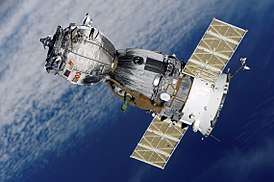Kosmos 133
Kosmos 133 (Russian: Космос 133, meaning "Cosmos 133"), Soyuz 7K-OK No.2, was the first uncrewed test flight of the Soyuz spacecraft, and first mission of the Soyuz programme, as part of the Soviet space programme.
_drawing.png) Soyuz 7K-OK(A) spacecraft with an active docking unit. | |
| Mission type | Uncrewed spacecraft |
|---|---|
| Operator | OKB-1 |
| COSPAR ID | 1966-107A |
| SATCAT no. | 02601 |
| Mission duration | 1 day, 23 hours and 19 minutes |
| Spacecraft properties | |
| Spacecraft | Soyuz 7K-OK No.2 |
| Spacecraft type | Soyuz 7K-OK |
| Manufacturer | OKB-1 |
| Launch mass | 6450 kg [1] |
| Start of mission | |
| Launch date | 28 November 1966 11:02:00 GMT [2] |
| Rocket | Soyuz 11A511 s/n U15000-02 |
| Launch site | Baikonour, Site 31/6 |
| Contractor | OKB-1 |
| End of mission | |
| Disposal | Exploded: on the self-destruct command of ground |
| Landing date | 30 November 1966, 10:21 GMT |
| Orbital parameters | |
| Reference system | Geocentric [2] |
| Regime | Low Earth |
| Perigee altitude | 171 km |
| Apogee altitude | 223 km |
| Inclination | 51.9° |
| Period | 88.4 minutes |
| Epoch | 28 November 1966 |
Launched from the Baikonur Cosmodrome aboard the maiden flight of the Soyuz 11A511 s/n U15000-02 [3] carrier rocket, Kosmos 133 was planned "all up" test, to include an automated docking with a second Soyuz (Soyuz 7K-OK No.1), which was scheduled for launch the day after Kosmos 133.
Kosmos 133 was operated in a low Earth orbit, at an epoch of 28 November 1966, it had a perigee of 171 kilometres (106 mi), an apogee of 223 kilometres (139 mi), an inclination of 51.9°, and an orbital period of 88.4 minutes.[2]
Problems found during ground testing of the second spacecraft resulted in its launch being delayed, and it was destroyed when its carrier rocket exploded on its launch pad following a scrubbed launch attempt in December. Before this, the attitude control system of Kosmos 133 malfunctioned, resulting in rapid consumption of orientation fuel, leaving it spinning at 2 rpm. After large efforts by ground control and 5 attempts at retrofire over two days, the craft was finally coming down for a landing. Due to the inaccuracy of the reentry burn, it was determined that the capsule would land in China. The self-destruct command was given and the satellite exploded 30 November 1966 at 10:21 GMT.[1]
The fireball passed over west Japan and was recorded by photos and a sketch. Kōichirō Tomita identified that it was the Kosmos 133 spacecraft (30 November 1966).[4]
References
- "Cosmos 133: Display 1966-107A". nssdc.gsfc.nasa.gov. NASA. 27 February 2020. Retrieved 31 March 2020.

- "Cosmos 133: Trajectory 1966-107A". nssdc.gsfc.nasa.gov. NASA. 27 February 2020. Retrieved 31 March 2020.
- McDowell, Jonathan. "Launch Log". Jonathan's Space Page. Retrieved 31 March 2020.
- 加茂昭, Kamo, Akira (2012). 空とぶマネキン人形 [Flying Mannequin Doll / Mannequin Cosmonaut]. Japan: Seikosha 星湖舎. ISBN 9784863720275.
